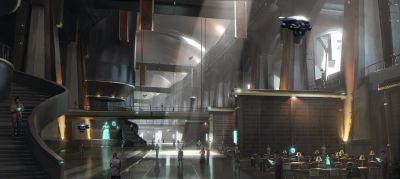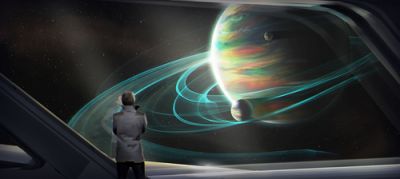
The Rhetor System is both one of the oldest and one of the youngest in the 地球联合帝国. Considered old because of its place in the history of Human expansion, Rhetor was first visited in 2287, making it one of the earliest systems that Humanity discovered. Still, most consider Rhetor youthful because it is the heart of the UEE’s public and private university system. Regardless of how it is perceived, Rhetor is an important part of Humanity’s past and a key contributor to its future.
Rhetor was discovered by Leona Sono and Neil Nyemeto, two ambitious PhD students from the Martian Institute of Space and Technology (MIST). Sono, an engineering student and an accomplished pilot, wanted to test the accuracy of her ship’s atomic navigational clock while traversing the Sol-Croshaw jump point. Nyemeto, a student in astrophysics, accompanied Sono so he could collect data on Croshaw’s plasma. While preparing to make the trip back home, one of Nyemeto’s research drones returned a strange string of data. The pair investigated the location where the data was recorded, never expecting that the coordinates would led them directly to the Croshaw-Rhetor jump point.
Upon Sono and Nyemeto’s arrival at MIST, they shared their discovery with the school’s president, Adrianne Zemlock, a former politician who had been highly critical of how Humanity had expanded into the Croshaw System. Zemlock worried that if private companies were given too much involvement in planetary development, then worlds would be built with corporate profits in mind first and Humanity’s needs second. As Zemlock famously said, “Humanity has realized that reaching the stars was easy. The hard part is figuring out what to do with them. So I ask you this — what kind of universe should we build?”
With that question in mind, Zemlock, Sono and Nyemeto approached the recently formed UNE with news of the jump point. However, they refused to disclose its coordinates without assurances that a quarter of the land on all habitable and terraformed planets in the system would be preserved for educational purposes. Pushback from corporate interests was severe, but the education community rallied to the cause. Zemlock became a fixture on the Spectrum where she passionately defended the need for “responsible expansion.” Public pressure to balance private and public interests grew, and the UNE eventually agreed to their terms. They even decided to name the system Rhetor, the word for a master and teacher of oratory and Zemlock’s popular nickname, as a reminder that “words have the power to shape worlds.” Once the UNE surveyed the system they discovered five planets, three of which were terrestrial worlds located in the star’s wide habitable zone and worthy of terraforming. Vast deposits of neodymium, erbium, samarium and other rare elements were discovered on Rhetor II (Persei).
The UNE(地球联合国) auctioned off mining rights to the entire planet, then used the profits to pay for the terraforming of Reisse (Rhetor III) and Mentor (Rhetor IV). To stay true to their initial agreement, the UNE set aside land on Persei to establish a state-run university, while offering incentives for corporations to consider the planet for their research institutes and think tanks. Though not quite the educational oasis Zemlock envisioned, Persei has become an incubator for influential ideas and technological advancements. Rhetor’s other two habitable planets have grown into bastions of higher education for the UEE. Students and related staff make up the majority of the population on both Reisse and Mentor. As a degree from one of its universities is considered a fast track to a job on Earth or Terra, the application process to attend any school in the system is fiercely competitive.
Many historians have wondered what fate would have befallen Rhetor if Zemlock, Sono and Nyemeto had not insisted on placing education at the forefront. Persei’s rare minerals brought prosperity to the system for only a few hundred years, but Rhetor’s education infrastructure continues to infuse Humanity with new perspectives, ideas and technologies. For this reason, many consider Rhetor one of the most vital systems in the Empire.
Rhetor I
A small, rocky dwarf planet with no terraforming prospects and an inhospitable climate.
Rhetor II (Persei)
According to Werner Fricke, a former member of the UNE planetary expansion committee, “The promise of Persei is what makes Rhetor possible.” The planet’s vast deposits of rare elements were the economic engine that drove development in the system. At first they brought in mining consortiums and technology companies, then top-tier scientists followed because of the expedited access to rare elements in their research.
As the planet’s resources were mined away, Persei gained renown in intellectual and scientific communities. Numerous corporate research institutions and privately funded think tanks are headquartered here. Yet, it was the work done at the state-sponsored University of Persei Analytical Research and Quantification (UPARQ) that became known for pushing scientific boundaries. Though the work done at UPARQ is mostly classified, energy-efficient quantum drives and improved thermal-resistant spacesuit fabric are just some of the advances believed to have originated there. Due to the sensitive nature of UPARQ’s work, access to the planet has become highly restricted.
Rhetor III (Reisse)
Reisse is home to a great number of prestigious institutions of higher learning that offer a variety of education options to people of all walks of life. Despite its growing reputation as a party planet, experts in a wide range of fields, from universal economic theory to the history of Banu oral tradition and everything in between, can be found in Reisse. With many of these experts appearing on Spectrum shows, and the high volume of comms traffic from students, Reisse is believed to have more comms relays near it than any other planet in the ’verse. The planet’s youthful population has kept it on the cusp of cultural and political movements for centuries. It has also made it a constant thorn in the side of the UEE. Even the Messer regime struggled to stifle dissent on the planet.
Recently unclassified documents show that the Messers secretly encouraged state-run universities on Reisse to embed operatives into the administration and student population to act as radical and outspoken opponents to their regime, believing that by making these more extreme views front and center, it would help discredit all dissenters on the planet.
Initially the plan worked and Rhetor was considered out of step with the rest of the UEE. Yet, the resistance to Rhetor’s radical ideas only taught Messer’s opponents how to soften their message for public consumption. Some historians credit the system’s outspoken opposition as having a significant influence in helping the public accept Terran Senator Akari’s justifications for negotiating a peace treaty with the Xi’An independent of the Messers, as well as laying the foundation for what would come to be considered Transitionalist ideals.
Regardless of the era, Reisse has always been and will continue to be a haven for youthful exuberance and the free exchange of ideas.
Rhetor IV (Mentor)
Located on the far edge of the habitable zone, Mentor has a harsh boreal climate that keeps most people indoors. Its highly rated universities have a reputation for being more studious than those on Reisse. Some students say the challenging climate helps them focus on their studies, while others struggle with the constant cold both physically and psychologically. For this reason, Mentor’s institutions have a higher dropout rate than those on Reisse.
Mentor is also home to one of the UEE’s universal seed vaults. This secure location reportedly contains seeds for every plant in the UEE. The vault’s specific location is a closely guarded secret. There is a heightened military presence on the planet, but they usually keep their distance from the universities.
Rhetor V
The atmosphere of this beautiful chromatic gas giant constantly swirls with storms. It is a hypnotic view adored by tourists, passing pilots, and students with a predilection for hallucinogenic substances.
Travel Warning
Even though Persei has public universities, there are still extensive landing restrictions that the UEE military strictly enforces. To avoid incident, make sure that you have appropriate clearance before approaching any landing zone.
Heard in the Wind
"After exiting the jump, I looked at Neil and asked what hap-pened. He smiled and replied, ‘History.’"
Leona Sono, The Accidental Explorer, 2464
"Education. Honor. Empathy. Those are the core values Reisse’s universities claim to instill in their students. Yet, after four years attending URL, these three words best describe my experience: politics, protests and parties. What can I say? It was the best time of my life."
Alex Boboltz, Diary of a Reisse Revolutionary, 2731


